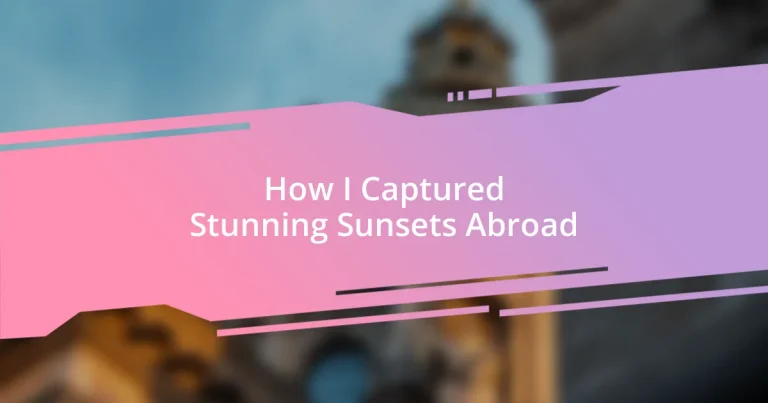Key takeaways:
- Timing and location are crucial for sunset photography; arriving early and scouting unique spots enhances the experience and results.
- Mastering camera settings, such as exposure and shutter speed, significantly impacts the quality and mood of sunset shots.
- Editing and sharing your sunset photos effectively can evoke emotions and foster connections, making each image more meaningful to your audience.

Preparing for Sunset Photography
When I think about preparing for sunset photography, the first thing that comes to mind is timing. I remember one evening in Santorini, watching the vibrant hues of orange and pink slowly overwhelms the horizon. Have you ever felt that rush of excitement as the light changes, knowing that you’re about to capture something truly magical? It’s thrilling.
Gathering the right gear is equally important. I always make a checklist: my camera, tripod, and filters, of course. There’s nothing worse than missing that perfect shot because you forgot something crucial—trust me, I learned that the hard way in Bali when I had to shoot with a shaky hand instead of a sturdy tripod. What essentials do you find indispensable in your own sunset photography adventures?
Lastly, scouting locations can’t be overlooked. I love arriving early, getting a feel for the landscape. Finding the perfect spot sometimes feels like a treasure hunt. Have you ever stumbled upon a hidden gem just minutes before sunset? I certainly have, and those moments often lead to my favorite photographs. Each sunset offers a unique canvas, waiting for us to frame it just right.

Choosing the Right Location
Choosing the right location is pivotal to capturing breathtaking sunsets. During my travels through the rocky cliffs of Cinque Terre, I stumbled upon a secluded viewpoint. It was one of those places where the sun dipped low against the colorful buildings, casting reflections on the water that I could hardly believe. That secluded spot became one of my all-time favorites, proving that sometimes the best locations are off the beaten path.
Here are some tips for selecting your ideal sunset location:
- Research popular sunset spots beforehand, but don’t shy away from lesser-known areas.
- Consider the landscape: mountains, beaches, or urban settings each offer unique qualities.
- Take note of prevailing weather patterns; clouds can create dramatic effects!
- Arrive early to explore and find the best angles for your shot.
- Engage with locals—they often know hidden gems that aren’t in guidebooks.
In my experience, it’s those unexpected moments in less-traveled places that often lead to the most stunning photographs. Trust me, the journey is just as rewarding as the sunset itself!

Timing Your Sunset Shots
Timing plays a crucial role in sunset photography. I’ve learned that arriving at my chosen spot well before sunset allows me to soak in the atmosphere and anticipate the perfect moment. For instance, during a trip to Thailand, I found myself enjoying a quiet beach while the sky gradually shifted colors. That buildup made the eventual explosion of reds and purples feel all the more exhilarating, and capturing it was immensely satisfying.
Capturing those fleeting moments isn’t just about physical timing; it’s also about understanding light conditions. I often set my camera to manual mode and experiment with my settings about 20-30 minutes before the sun begins to dip. This window provides a fantastic opportunity to adjust for the rapidly changing light. One memorable evening in Costa Rica, I fiddled with my exposure settings just as the sun started its descent, which resulted in a mesmerizing shot that perfectly captured the glowing sky mirrored in the water.
To help you understand the optimal times for capturing stunning sunsets, here’s a comparison of the golden hour, blue hour, and the moments right before and after sunset:
| Timing | Description |
|---|---|
| Golden Hour | About an hour before sunset; soft, diffused light creates warm tones. |
| Sunset | Peak moment when the sun is on the horizon; vivid colors emerge. |
| Blue Hour | After sunset; rich blues and purples fill the sky, ideal for dramatic shots. |

Camera Settings for Sunsets
When it comes to camera settings for sunsets, I’ve found that tweaking your exposure can make all the difference. During a magical evening in Santorini, I adjusted the ISO to 100 and the aperture to f/11 to capture the vibrant hues without losing detail in the foreground. You might notice the sky morphing into an artist’s palette, so keep an eye on your histogram to ensure you’re not blowing out those stunning highlights.
I also favor using a slower shutter speed to bring out the soft gradients in the sky. One time, while standing on a rocky beach in Maine, I set my shutter speed to 1/60 second. The result was breathtaking—the gentle waves danced in the foreground, harmonizing beautifully with the fiery sky behind. Have you ever stopped to appreciate how different shutter speeds can change the mood of your sunset images?
Don’t forget about white balance, which can dramatically alter the mood of your photo. I usually set it to “cloudy” when shooting sunsets; this adds warmth to the already rich colors, making every image feel sunnier. A few years back, on the outskirts of Lisbon, I was experimenting with different settings, and that adjustment brought a cozy glow to the scene. Trust me, the right camera settings not only preserve the moment but also enhance the emotions tied to your travel memories.

Composition Techniques for Stunning Sunsets
When composing sunset shots, I’ve found that using framing techniques like the rule of thirds can transform an ordinary image into something extraordinary. By placing your horizon line off-center, I’ve noticed that the sunset becomes more dynamic, pulling the viewer’s eye across the landscape. In Bali, I once positioned a silhouette of a palm tree to the left, and it felt like a secret doorway leading into the breathtaking colors of the sky.
Another technique I cherish is incorporating foreground elements to add depth. This strategy became evident to me while hiking in the Norwegian fjords; I stumbled upon a field of wildflowers. By capturing both the blooms and the sunset, I created an enchanting scene that invited viewers to step into that serene moment with me. Can you imagine how much more captivating a sunset can feel when it’s framed with vibrant elements like flowers or rocks?
Finally, don’t underestimate the power of perspective. Shooting from a lower angle can dramatically enhance the sky in your composition. I recall a breathtaking evening along the Amalfi Coast where I laid on the rocky beach, capturing a view of the sun dipping below the cliffs. The result was a stunning contrast of dark rocks against the burning orange sky, creating an image that felt intimate and expansive at once. Sometimes, just a simple shift in your viewpoint can lead to the most striking photographs.

Editing Tips for Sunset Photos
One of my favorite editing tips for sunset photos is to play around with saturation and contrast. I often take my vivid sunset images and slightly increase the saturation to emphasize those warm oranges and purples. During a trip to the lavender fields in Provence, I found that enhancing contrast really made the sunset pop against the delicate petals. It’s amazing how a few adjustments can transport you back to that serene moment, don’t you think?
When it comes to sharpening, I recommend being cautious. Overdoing it can make the sky appear gritty instead of smooth. I learned this the hard way while editing some stunning shots from a sunset in the Maldives. The raw images were ethereal, but cranking the sharpness too high resulted in a harsh finish. Now, I focus on subtle enhancements to maintain that dreamy quality that sunsets naturally possess. It’s those little details that truly keep the magic alive in your photos.
Lastly, consider experimenting with filters and presets to add a unique touch to your sunset images. For instance, I often use a warm vignette to create a cozy, inviting atmosphere. I remember sitting with my laptop in a quaint café in Florence, scrolling through my sunset captures, and discovering that a slight vignette brought out the elegance I felt when I witnessed those colors bleed across the Tuscan sky. It’s all about evoking the emotions tied to those memories; what kind of feelings do you want your photos to inspire?

Sharing Your Sunset Photography
Sharing your sunset photography can be a deeply rewarding experience. I remember the thrill of posting a sunset shot from Santorini on social media, and the flurry of comments from friends who felt like they were right there with me. Engaging with your audience makes each image feel like a shared story rather than just a standalone picture. Have you ever felt that rush when someone connects with your work?
When you choose to share your sunset photos online, consider the caption’s power. I often take a moment to reflect on what that sunset meant to me; it’s my way of inviting others into my emotions and memories from the moment. For instance, I once paired a captivating sky from a beach in Thailand with a quote about fleeting beauty, and it resonated with many, sparking conversations about travel and life’s transience.
Don’t hesitate to experiment with different platforms! I’ve found that Instagram’s visual focus allows for a more engaging showcase, while blogs give me the chance to dive into the stories behind each shot. A photo from a stunning sunset in the Sahara desert became part of a larger narrative about my travel experiences, and honestly, I loved elaborating on the sense of peace I felt surrounded by such vastness. How do you curate your sunset memories?














